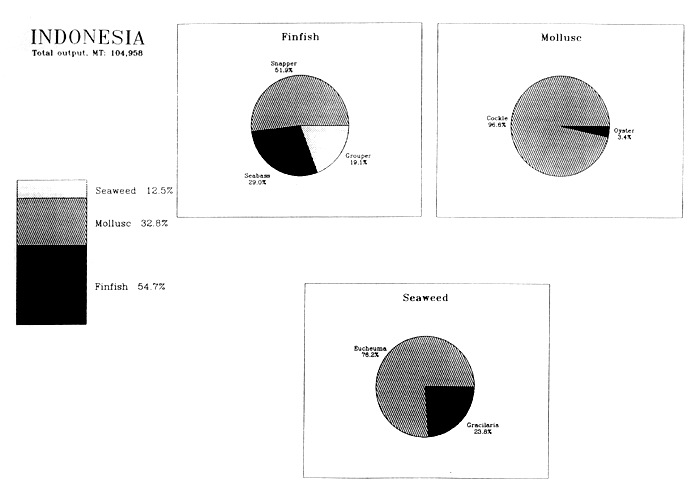
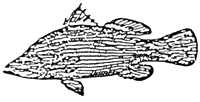 | Lates calcarifer |
CULTURE PRACTICES
Seabass in Indonesia are cultured in earthen ponds as well as in floating netcages. There are two systems employed in pond culture: mono- and poly-culture. On the other hand there are two kinds of cages used in seabass culture. A) Floating netcages: the netcages are fixed on a floating wooden beam, bamboo pole or galvanized pipe framework. B) Stationary cages: the netcages are fixed to the sea bottom at its four corners using wooden beams or bamboo poles. In the floating system the netcage wooden frame is kept afloat by means of plastic or oil drums. Polyethylene netcages of various dimensions are used in the floating netcage system, usually 5×5×3 m or 3×3×3 m. Feeding of chopped fresh trash fish is provided to the cultured fish twice daily, in the morning and afternoon. The amount of feed given is about 8–10% of the total biomass of the stocked fish. During the culture period, the netcages are changed every month in order to guarantee a good water flow and prevent outbreak of diseases. The market size fish are harvested from the netcages by pulling the net on one side of the fram unit.
PRODUCTION
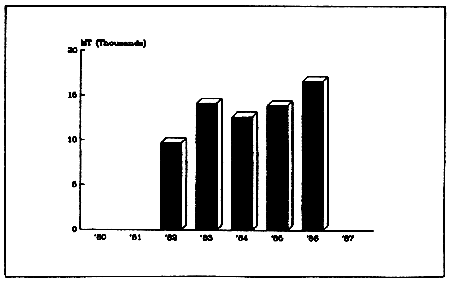
HISTORY
In Indonesia seabass have long been known as a by-product of brackishwater harvests. Seabass fry enter and become trapped in the earthen ponds through the water inlet during high tide. Seabass commands a good market price. The fry of this species mostly comes from the wild, however their supply is poor compared to the present demand. To alleviate the problem, a hatchery was constructed in Lampung. The National Seafarming Development Centre in Lampung succeeded in inducing spawning and producing seabass fry in April 1987 by hormone manipulation.
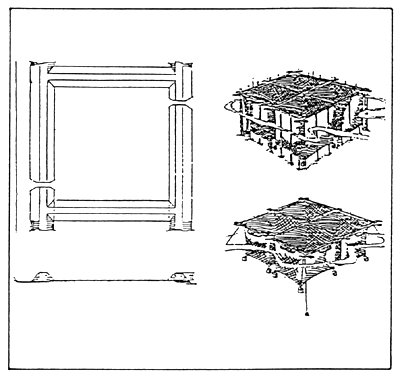
TOTAL REGIONAL PRODUCTION
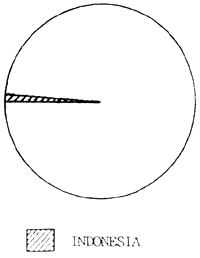
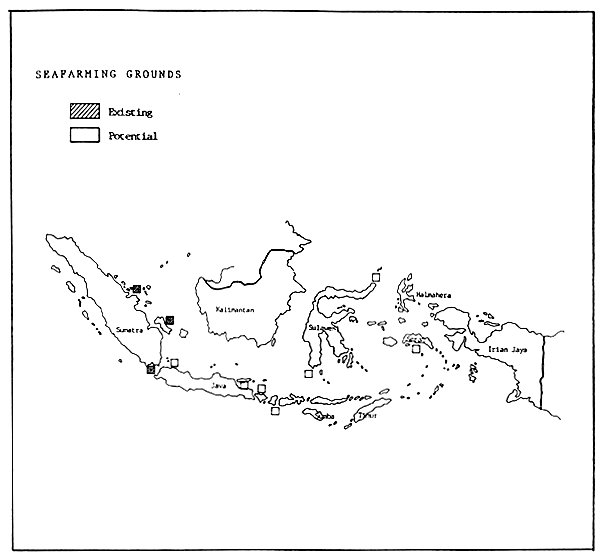
STATUS OF CULTURE
| TOPIC | SPECIES | 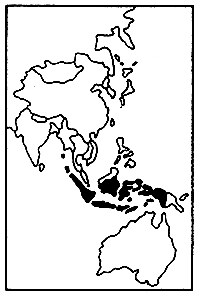 |
| Lates calcarifer | ||
| Source of seed | Wild and artificial | |
| Culture method | Pond and floating netcage | |
| Yield/ha | NA | |
| Market | Domestic | |
| Production area | NA | |
| Status of culture | Developed | |
| Major constraints | Limited seed supply Lack of high quality feed | KEY MAP |
 | Epinephelus tauvina Epinephelus malabaricus |
CULTURE PRACTICES
Fish farmers have been traditionally rearing wild grouper juveniles in floating netcages. The size of the netcages varies considerably although the typical sizes are 2×2×2, 3×3×3 or 5×5×5 m depending on the number of fry available. The frames used for supporting the netcages are made of wooden beams, bamboo poles or galvanized pipes. One raft unit usually comprises 4 netcages 3×3×3 in size and 12 plastic drums of 100-litre capacity (used as floats). Low value trash fish is provided to the cultured fish twice daily in the morning and afternoon. The amount of feed given is about 8–10% of the total biomass of the stocked fish and weight gain is 2– 5% of total body weight. During the culture period, the netcages are changed every month in order to guarantee a good water flow and prevent outbreak of diseases. The market size fish are harvested from the netcages by pulling the net on one side of the frame unit and slowly concentrating the fish by marginally lifting the net panel over the edge of the frame. The estimated total area suitable for finfish netcage culture is about 2,900 ha.
PRODUCTION
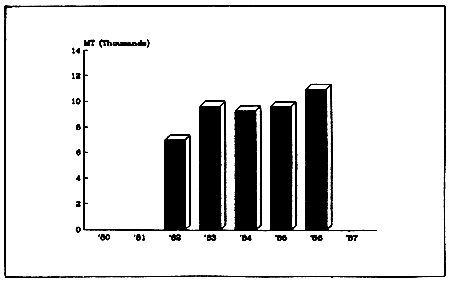
HISTORY
Grouper culture in floating netcages and pens is commonly practiced in Bangka and Belitung Islands as well as in the Riau Archipelago. The culture of this marine finfish is mostly practiced by local fisherman as a sideline activity, thanks to the high demand of live fish in Singapore. At present, the National Seafarming Development Centre in Lampung is attempting to artificially culture grouper fingerlings, but initial trials have been discouraging due to high mortality rate of the young fry. Most of grouper production in Indonesia comes from capture fishery

TOTAL REGIONAL PRODUCTION

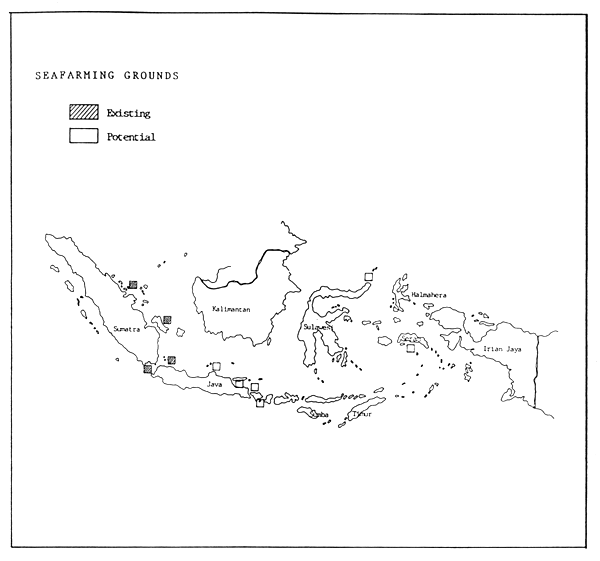
STATUS OF CULTURE
| TOPIC | SPECIES | 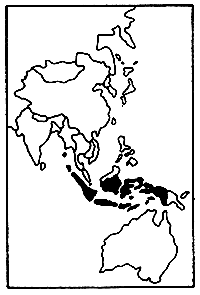 |
| E. tauvina & E. malabaricus | ||
| Source of seed | Wild | |
| Culture method | Floating netcage | |
| Yield/ha | NA | |
| Market | Domestic and export | |
| Production area | NA | |
| Status of culture | Developed | |
| Major constraints | Limited seed supply Lack of high quality feed | KEY MAP |
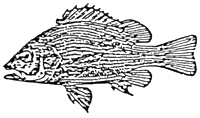 | Lutjanus argentimaculatus Lutjanus johni |
CULTURE PRACTICES
Snappers are cultured in floating or stake netcages or in pens. More research is required to refine culture techniques as well as extension work to familiarize local fisherman with such an alternative activity. In the floating system the netcages are fixed on a wooden frame kept afloat by means of plastic or oil drums. In the stake system the netcages are fixed to wooden pole which have been driven into the bottom. Polyethylene netcages of various dimensions are used in the floating netcage system, usually 5×5×3 m or 3×3×3 m. Feeding in the form of chopped fresh trash fish is provided to the cultured fish twice daily in the morning and afternoon. The amount of feed given is about 8–10% of the total biomass of the stocked fish. During the culture period, the netcages are changed every month in order to guarantee a good water flow and prevent outbreak of diseases. The market size fish are harvested from the netcages by pulling the net to one side of the frame unit and slowly concentrating the fish by marginally lifting the net panel over the edge of the frame. The fish are scooped into holding tanks in boats.
PRODUCTION

HISTORY
Snappers are a well known and appreciated marine finfish species in Indonesia and are often a by-product of shrimp trawlers. These species have a high local and export demand and command a relatively high market price. Snappers are usually cultured in floating netcages and pens in areas around the Riau Archipelago, Bangka and Belitung Islands. The main constraint related to this seafarming activity is the limited availability of fry which is entirely collected from the wild. Further constraints are the lack of high quality feed and trained personnel.
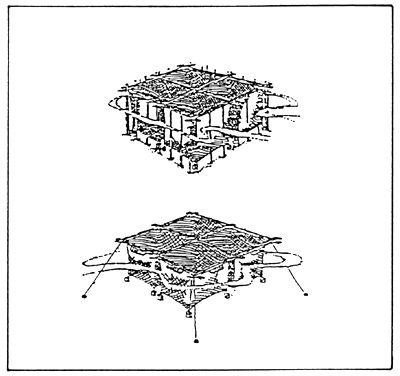
TOTAL REGIONAL PRODUCTION
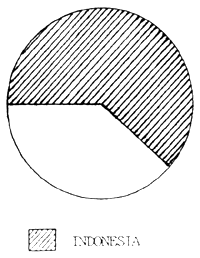
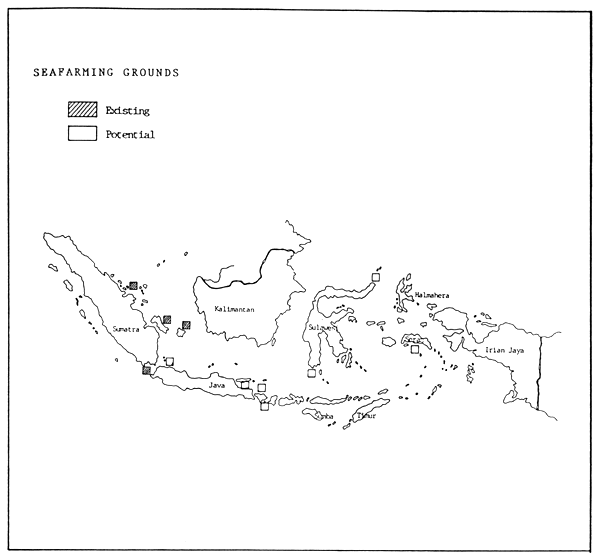
STATUS OF CULTURE
| TOPIC | SPECIES |  |
| L. argentimaculatus & L. johni | ||
| Source of seed | Wild | |
| Culture method | Floating netcage | |
| Yield/ha | NA | |
| Market | Domestic | |
| Production area | NA | |
| Status of culture | Developed | |
| Major constraints | Limited seed supply Lack of high quality feed | KEY MAP |
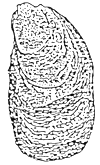 | Saccostrea cucullata |
CULTURE PRACTICES
Bottom, pole and hanging methods are used to culture oysters. Bamboo poles, which are driven in muddy substrates, are readily available and relatively cheap. This method is widely practiced as it is economical, with a lower initial capital investment than other methods. Cement pipes and racks are also used in muddy bottoms. In the hanging method, spat collectors are made of cement palm composite or asbestos sheets which are then hung from a horizontal wooden frame. Although this method has a high production output it is not widely used, mainly due to the high initial investment cost. The time of spat collection varies according to locality, however the peak season at Marunda, Jakarta is between February and March. Although oyster culture has not yet developed, some 7,300 ha have been identified as potential sites. Some of these surveyed sites are Ketapang, West Java; Demak, Jepara in Central Java; Kenjeran, Pasuruan and Kwanyan in East Java; Lombok Bay and Bima Bay in West Nusa Tenggara; Kupang Bay Timor in East Nusa Tenggara and Maros in South Sulawesi.
PRODUCTION

HISTORY
Several species of oysters belonging to the Crassostrea and Saccostrea genera are found in Indonesia. Most of the oyster production comes from natural grounds in intertidal and subtidal areas. Oysters are harvested by fishermen and normally consumed locally. Oyster culture in Indonesia was first attempted in the mid-80's and at present small-scale culture practices can be observed at Kwanyan in Madura Island, East Java. Other areas where oysters are harvested from natural grounds are the Malacca Strait, north-western Java, Sulawesi and southern coast of Seram and Irian Jaya.

TOTAL REGIONAL PRODUCTION

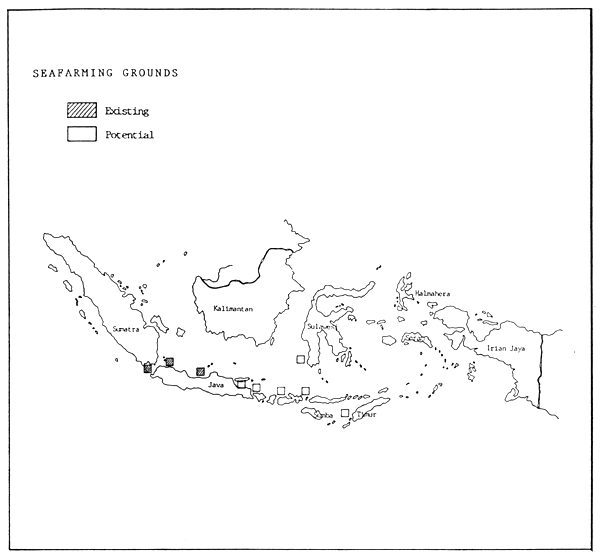
STATUS OF CULTURE
| TOPIC | SPECIES |  |
| Saccostrea cucullata | ||
| Source of seed | Wild | |
| Culture method | Pole (bamboo) | |
| Yield/ha | NA | |
| Market | Domestic | |
| Production area | NA | |
| Status of culture | Developed | |
| Major constraints | Limited seed supply Marketing | KEY MAP |
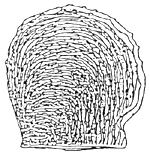 | Pinctada maxima |
CULTURE PRACTICES
The method typically used for culturing pearl oysters is the raft method. Basket nets are used for intermediate culture while operated oyster are cultured in plastic coated or galvanized wire cages. The cages are usually suspended from a raft unit at a depth of 6–8 m. The size of adult oysters which undergo operation are 15–25 cm in length, while the diameter of the nuclei is 5–10 mm. Round pearls are usually harvested in 2–2.5 years after nucleus insertion, while a shorter period (9–11 months) is required for blister production. At present there are 24 companies operating pearl culture farms in the Indonesian archipelago. In 1987 pearl culture activities were also introduced in Hurun Bay, Lampung by the Indonesian Government. The amount of pearls produced in Indonesia is not registered, however it is believed that the industry is expanding. Existing culture areas are scattered all over the country. Numerous potential sites have been identified. The major constraints to the expansion of this seafarming activity are the lack of trained personnel, limited seed supply and availability of nuclei.
PRODUCTION
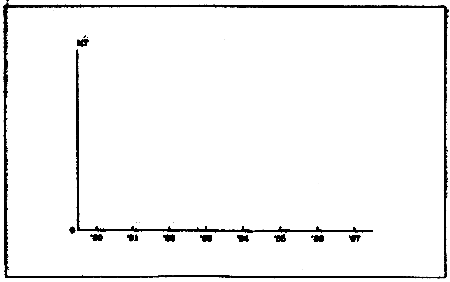
HISTORY
Pearl oyster farming was first started in Indonesia before WW II in Para Besar and Buton Islands by Japanese entrepreneurs. However, during the war this culture activity was transferred to Parau Island in Micronesia, but unfortunately it soon ceased operating. In 1963 pearl farming was again started in Buton Island by several Japanese companies. Indonesia has four species of pearl oysters, all of which are suitable for culturing pearls: the gold lip oyster, Pinctada maxima; the black lip oyster, P. margaritifera; the wing oyster, Pteria penguin and the Japanese pearl oyster Pinctada fucata.
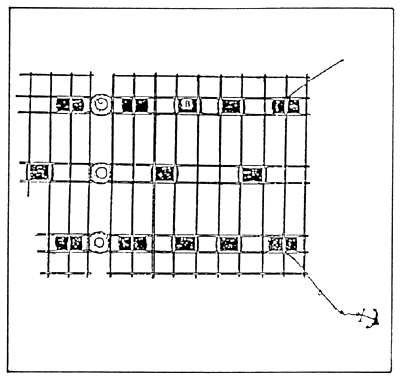
TOTAL REGIONAL PRODUCTION

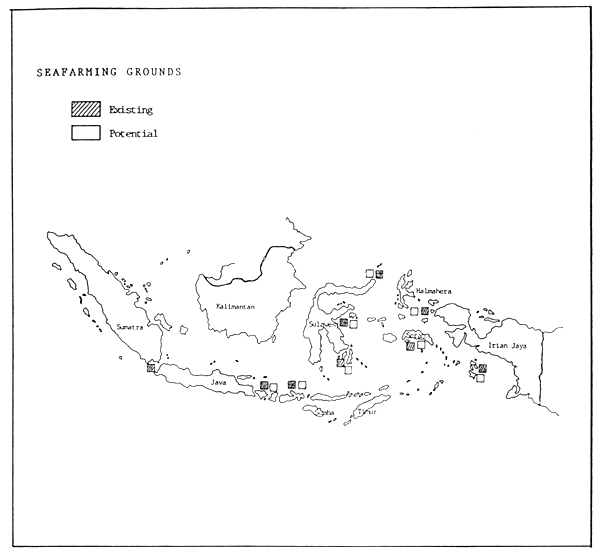
STATUS OF CULTURE
| TOPIC | SPECIES |  |
| Pinctada maxima | ||
| Source of seed | Wild | |
| Culture method | Raft | |
| Yield/ha | NA | |
| Market | Export | |
| Production area | NA | |
| Status of culture | Developed | |
| Major constraints | Limited seed supply Lack of instrument for operation Availability of nuclei | KEY MAP |
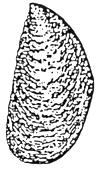 | Perna viridis |
CULTURE PRACTICES
The two most basic culture methods have been introduced in Indonesia: stake and hanging methods. In the former method bamboo poles 10 cm in diameter and 5–6 m in length are typically used by driving them into muddy seabeds. The poles are arranged in rows 1 m apart with each row being 2.5–3 m apart. In the hanging method polyethylene ropes are used as collectors which are hung from a fixed horizontal frame. The raft and long-line methods have also been introduced to Hurun Bay, Lampung. The culture of green mussel in Indonesia is experiencing a very slow advance mainly due to consumer preferences and health concerns. At present, no sanitary controls are imposed on collected bivalves. For the above reasons there is a low market demand for shellfish and little incentive to invest in shellfish culture. The Indonesian government is trying to promote the culture and consumption of mussel. Numerous potential areas suitable for culturing mussel on pole and raft have been identified throughout the country particularly in Kuala Penet (Lampung), Banten Bay (West Java), Ancol Bay (Jakarta), Jepara (Central Java) and Mwanyan (East Java). The total area is around 19,700 ha.
PRODUCTION
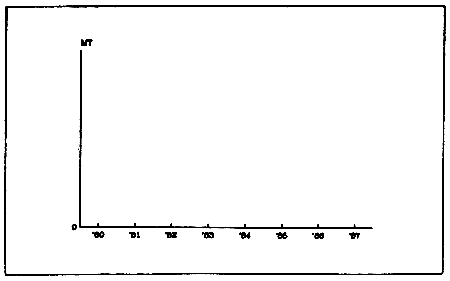
HISTORY
Green mussel culture in Indonesia was first attempted at Ancol, Jakarta Bay in 1980. However, it did not expand due to pollution of the waters. About 200 MT/ha/yr were produced when the bamboo stick method was used. In 1985 a commercial trial was carried out by the FAO/UNDP Seafarming Development Project (INS/81/008) in cooperation with the Seafarming Centre Lampung at Kuala Penet, Maringgai, Lampung. By using the hanging method from a fixed horizontal wooden frame, 160 MT/ha/yr were obtained. At present, mussel culture is not commercially practiced.

TOTAL REGIONAL PRODUCTION
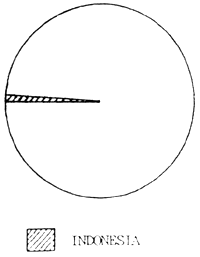
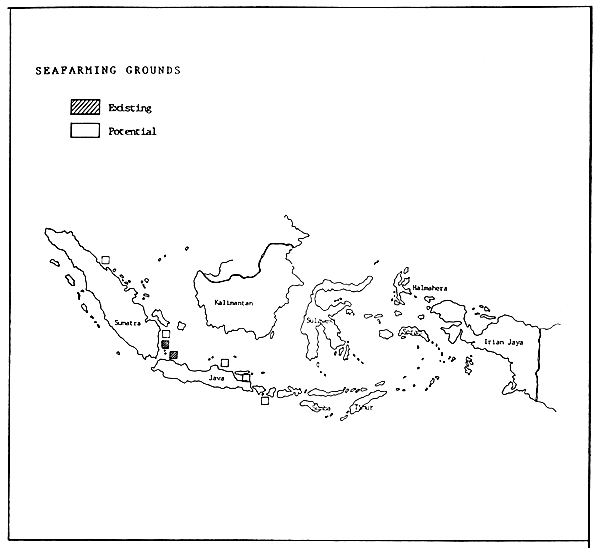
STATUS OF CULTURE
| TOPIC | SPECIES | 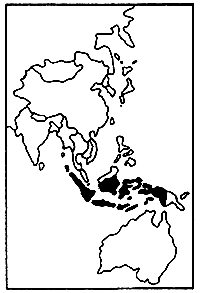 |
| Perna viridis | ||
| Source of seed | Wild | |
| Culture method | Pole (bamboo), hanging and raft | |
| Yield/ha | NA | |
| Market | Domestic | |
| Production area | NA | |
| Status of culture | Developed | |
| Major constraints | Limited seed supply Marketing | KEY MAP |
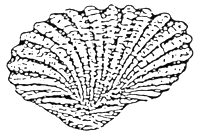 | Anadara granosa Anadara inflata |
CULTURE PRACTICES
Two species of cockles are harvested in Indonesia: Anadara granosa and Anadara inflata. The total bivalve production in 1986 amounted to 46,350 MT of which the blood cockle (A. granosa) accounted for 92%. Cockles are cultured exclusively in the bottom. Pens are constructed using a bamboo screen which is driven into the mudflats mainly to prevent predators from entering the culture area. Sowing method in unprotected areas is also practiced, however the cockles are at the mercy of poachers. Cockle seed of 10–15 mm in size are usually stocked at a density of 150–200 pieces/m2. Cockle culture is being carried out mainly in the south east coast of Sumatra and north west Java. The potential area suitable for culturing this bivalve has been estimated at about 16,500 ha. The main areas are Tj. Balai, North Sumatra; Kuala Penet, Lampung; Maug Tangerang, West Java; Demak, Jepara, Tayu Pati and Rembang in Central Java, Kenjeran, Pasuruan and Probolinggo in East Java and Bima Bay in West Nusa Tenggara. One of the major constraints to cockle culture expansion is the limited seed supply. Market constraints also need considerable attention.
PRODUCTION
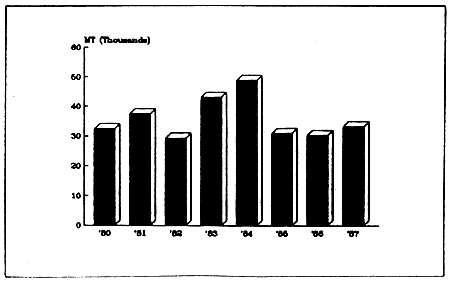
HISTORY
Cockle farming has been practiced by local fishermen in Mauk, Ketapang (West Java) since the 1950's. The culture of this bottom dwelling bivalve is very much dependant on the availability of natural seed. Cockle culture was at a stand still in 1975 due to the lack of seed as a result of poor natural spatfalls. From 1950 to 1969 the average annual production was around 5 MT/ha/yr. The potential area available for this kind of culture is estimated to be around 22,800 ha. Attempts at artificial production of cockle spat are at an initial stage.

TOTAL REGIONAL PRODUCTION

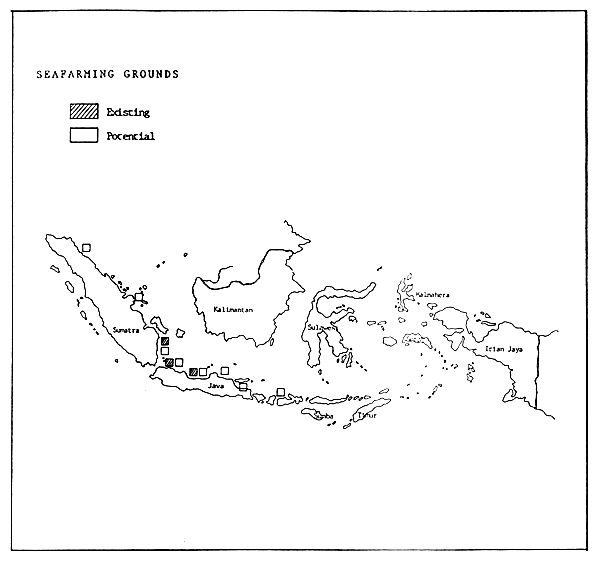
STATUS OF CULTURE
| TOPIC | SPECIES |  |
| A. granosa & A. inflata | ||
| Source of seed | Wild | |
| Culture method | Pen | |
| Yield/ha | NA | |
| Market | Domestic | |
| Production area | NA | |
| Status of culture | Developed | |
| Major constraints | Limited seed supply Marketing | KEY MAP |
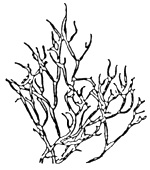 | Gracilaria verrucosa |
CULTURE PRACTICES
Pond culture of Gracilaria verrucosa follows the sowing method. The young twigs are either planted on the bottom, fixed to bamboo poles or covered with old fish nets to prevent drifting. Gracilaria ponds are constructed in areas which are not exposed to strong winds and with a sufficient tidal difference to facilitate water management operations. The selected sites usually have a source of freshwater which is required to dilute seawater when its salinity level becomes too high as a result of evaporation. Stocking density is in the range of 3,000 to 5,000 kilograms (wet seaweed) per hectare. The water is changed once every 2–3 days during the rainy season, while daily during the dry season. Fertilization is often done with 3 kilogrammes urea or 120–180 kilogrammes fermented manure every 2–3 days when the water is introduced. Due to the direct relationship between light intensity and Gracilaria growth, the water level in the pond is adjusted according to the season. During the dry season the water level is usually in the range of 40–80 cm. This is reduced to 30–50 cm during the rainy season.
PRODUCTION

HISTORY
Pond culture of seaweed appears to be a good alternative in many areas where fish and shrimp culture has become unproductive. Many of these abandoned ponds are suitable for culturing Gracilaria. Thus, there is a good prospect for maximizing the utilization of these areas through seaweed culture. Pond culture of Gracilaria verrucosa was first introduced in Indonesia in 1984. Gracilaria farming is being practiced in some coastal ponds in Java and in south Sulawesi. Suitable sites have been identified in the northern and eastern coast of Java and in Sumatra.
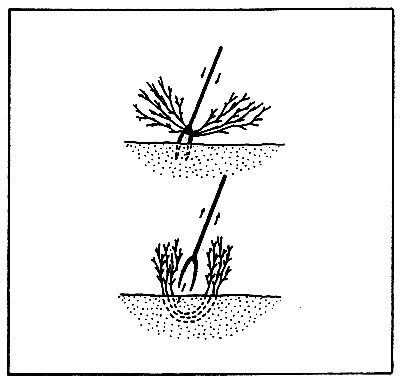
TOTAL REGIONAL PRODUCTION
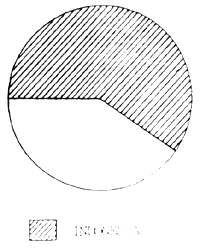

STATUS OF CULTURE
| TOPIC | SPECIES | 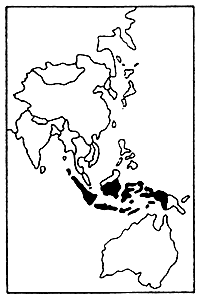 |
| Gracilaria verrucosa | ||
| Source of seed | Wild | |
| Culture method | Pond | |
| Yield/ha | 8–10 MT/ha | |
| Market | Export | |
| Production area | NA | |
| Status of culture | Developed | |
| Major constraints | Unsatble market Post-harvest technology | KEY MAP |
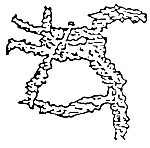 | Eucheuma cottonii |
CULTURE PRACTICES
Two culture methods are practiced in Indonesia: the stake and line method (monoline) and the raft method. The former is non-laborious, rather economical and easy to manage. It is suitable in protected site with flat sea bottoms and a tidal range of 0.5 m during low tide and 2.0 m during high tide. The monoline method consists simply of a nylon line placed 20–30 cm off the bottom and fixed at the two extremities to mangrove stakes driven to the bottom. A typical culture unit covers an area of 500 square meters consisting of 500 lines of 5 m each running parallel to one another. On each monoline 25 plants with an initial weight of about 70 grams are fixed at a distance of 20–25 cm. The raft method is usually more labour-intensive and can be used in sites with sloping bottom. The raft usually consists of a bamboo framework measuring 2.5×5 m on which 25 lines are fixed parallel to one another. The Eucheuma plants are harvested manually when they reach a weight of 750–850 g. harvesting is often practiced during the periodic maintenance activities. The harvested plants are left to dry under the sun and eventually packed in sacks.
PRODUCTION

HISTORY
Various national research institutes have been actively involved in the development of Eucheuma farming since 1974. Initial culture trials tested both the monoline and floating raft methods. The species currently being cultured in greatest quantity are Eucheuma cottonii and Eucheuma spinosum. Eucheuma culture was first developed in Bali. At present, Bali has over 2,000 Eucheuma farmers planting over 200 hectares. The major culture sites in Bali Island are Badung, Jemberana and Klungkung.
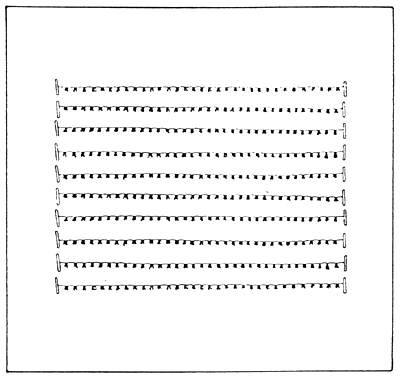
TOTAL REGIONAL PRODUCTION


STATUS OF CULTURE
| TOPIC | SPECIES | 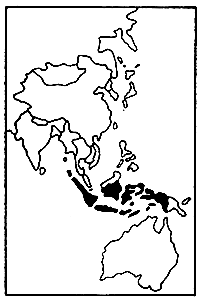 |
| Eucheuma cottonii | ||
| Source of seed | Wild | |
| Culture method | Monoline and raft | |
| Yield/ha | 8–12 MT/ha | |
| Market | Export | |
| Production area | NA | |
| Status of culture | Developed | |
| Major constraints | Unstable market Post-harvest technology | KEY MAP |